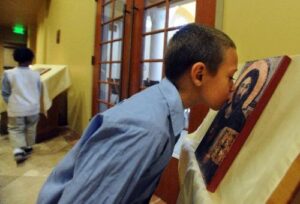
Venerating The Icon of Christ in Colorado
Wesley and Kevin made a number of comments that I thought were thoughtful and substantive. Rather than bury my response in the comments I decided to post them in this blog posting. I’ve expanded my defense of the veneration of icons by discussing the different ontologies between the Reformed and Orthodox traditions and a discussion of the Protestant principle of soli deo gloria (to God alone be the glory).
No Depicting of God, No Religious Devotion to Images
Wesley wrote,
The Second Commandment makes a strict prohibition against the depicting of God and against the offering of religious devotion to images. The concern of Exodus is that no one tries to depict God as a creature in an image, and that no one treats an image with religious devotion. (I am repetitive here to emphasize the point.)
With respect to the first point Wesley made a good point, one that the early church fathers would agree with. I noted in my earlier blog posting “Calvin vs. the Icon”:
John of Damascus anticipated the main thrust of Calvin’s argument against icons when he argued that the Old Testament injunction against images was given in order to prevent the Israelites from attempting to represent the invisible God. He noted however that the situation changed with the Incarnation.
It is clearly a prohibition against representing the invisible God. But when you see Him who has no body become man for you, then you will make representations of His human aspect. When the Invisible, having clothed Himself in the flesh, become visible, then represent the likeness of Him who has appeared. When He who, having been the consubstantial Image of the Father, emptied Himself by taking the form of a servant, thus becoming bound in quantity and quality, having taken on the carnal image, then paint and make visible to everyone Him who desired to become visible (in Ouspensky 1978:44).
With respect to treating “an image with religious devotion” there is a whole word study section ‘The Philological Argument’ in my article “Calvin Versus The Icon” about the distinction between worship of the true God, idolatry which is worship offered to any but God, and veneration which we see the saints of old giving to men. What matters is the intent behind the action, not just the act itself. In Genesis 43:28 we read of Joseph and his brothers: “And they bowed low to pay him honor.” Similarly, when Abraham entered into negotiations with his Hittite hosts he showed them extreme courtesy by bowing to them (Genesis 23:7, 12). This is radically different from Revelation 19:10 in which the angel rebuked John, not for falling on his face, but for intending to give him worship (as indicated by the infinitive form προσκυνησαι).
For further reading I recommend Timothy Copple and Patrick Barne’s article “Presumptuous Propositions.”
Icons and True Worship
Wesley wrote:
Your statement that we “cannot have truly Christian worship in a place where icons are purposefully excluded” is, to be candid, ridiculous. The Father is seeking those who will worship him in spirit and in truth. If we can worship the Father in spirit and in truth without the use of icons, then your statement is proven false, and Nicaea II is simply dead wrong. When the Ecumenical Councils speak against or out of harmony with the Scriptures on any point, they ipso facto do not speak for the Church on that point.
First, of all in an inter-faith dialogue like this one should be very careful about using pejorative adjectives like “ridiculous.” I make it a point never to call a student’s question “stupid.” Derogatory labels can have a chilling effect on open dialogue. I would prefer something like: “I strongly disagree with that.”
Second, Jesus’ statement in John 4:24 that God is to be worshiped in spirit and truth can be understood as referring to God being worshiped in the Spirit (the Holy Spirit) and in Truth (Jesus), i.e., the Trinity. If you are asserting that “worship in spirit” means disembodied worship then I think that interpretation has gnostic implications I am not comfortable with. So your refutation of Nicea II on the basis of John 4:24 is based upon one particular interpretation. Nicea II rests upon a broader hermeneutical tradition. I would challenge you to show the hermeneutical tradition behind your interpretation of John 4:24. Who among the church fathers supports you?
Internal Apostolic Tradition
Wesley accepts the idea of apostolic succession at least in the sense of the handing on of a set of teachings:
Third, if there is this distinction between internal and external apostolic succession, it only favors Protestants, for it allows for there to be the existence of one without the other. For example, he [Kabane] mentions that Roman Catholicism has the external succession of ordination without having maintained the internal succession of faith. I would say, in the very least, the Reformed faith-tradition has maintained the internal succession without maintaining the external.
Wesley claims that the Reformed tradition is legitimate because it rests on a historical tradition just as much as Eastern Orthodoxy:
…the Reformed faith-tradition may possibly be acknowledged and accepted as a legitimate or authentic expression or form of Christianity since it possibly possesses an internal apostolic succession of faith and truth. I would contend it is indeed the case that the Reformed faith-tradition has maintained the true faith.
I believe that Kabane accurately represented the Orthodox understanding of the importance of internal apostolic succession along with external apostolic succession. Whether or not the Reformed tradition is rooted in an internal apostolic succession has yet to be proven.
To prove his assertion Wesley would need to do the following: (1) list the main points where the Reformed tradition differs from the Orthodox tradition and (2) provide historical evidence of a continuous patristic tradition that affirm the Reformed doctrine or practice. The word “continuous” means that one or two isolated quotations will not suffice but rather a number of citations and conciliar decisions that meet the criteria of the Vincentian canon.
Mere Practice and When Scripture is Silent
Kevin writes:
...such is an argument from silence since there is nowhere recorded in the Scriptures such things for the treatment of icons of saints, Jesus Christ, or God. Whatever later Jewish or even Christian tradition has done in various places in the history of God’s people is also irrelevant since mere practice does not equate to endorsement by the Scriptures of the same. The history may inform our view but it does not require us to submit to its witness.
If I understand Kevin correctly he is not dismissing the usefulness of history, rather he is insisting that whatever lessons we might learn from history never rises to the rank of Scripture. Furthermore should they differ, history yields to Scripture. The Orthodox position is that the Apostles commanded an equal respect for their Tradition within the text of Scripture. The Church functioned on the basis of that prior regard for Tradition before settling in Council just which texts should be regarded as Scripture. The early church read Scripture within the context of Tradition, nowhere drawing a bright red line like the Protestants who a thousand years later would subordinate Tradition to Scripture. We must not be selective in our approach to history, taking only what we like and trashing history or the Tradition of the Church whenever it contradicts our own new Tradition. Nor can we claim that our new Tradition is pure biblical exegesis when it is divorced from the Tradition the Apostles commanded their disciples to obey.
So what does one do in the face of competing Tradition(s)? I would say: by finding the True Church. If you leave the Holy Spirit out of the equation in I Timothy 3:15 the result is rationalistic argumentation.
Protestants have a low view of the Visible Church (the Church Militant); it can be divided, contain an admixture of truth and error (hence the many denominations), and is not seen as the pillar and ground of truth (I Timothy 3:15). For Protestants there is no true, visible Church, and no continual, trustworthy corporate guidance from the Holy Spirit (i.e., the Holy Spirit guidance is only for individual Christians). This low view of the visible church is understandable in light of the excesses of medieval Catholicism which sparked the Protestant Reformation. But once I found the Church that Paul spoke of in I Timothy 3:15, I found stability for my doctrine and for my reading of Scripture. I believed that her dogmas were all true, that the Holy Spirit has infallibly guided and preserved her since Pentecost. The Holy Fathers of every Ecumenical Councils believed this. Shouldn’t you? Vladimir Lossky wrote: “Tradition is the life of the Holy Spirit in the Church.” Thus, Tradition does not stand over the Church; rather the Church preserves, passes on, and proclaims her Tradition. From our perspective the Protestants seem to view Scripture as something that fell from heaven like the Koran, and that the Church is just some fallible, human organization which is accountable to an external Book. God promised in the Old Testament the coming of the Holy Spirit to indwell the people of God. The Church is the “pillar of truth” preserving the Apostolic tradition in both written and oral forms.
Note: this paragraph is a paraphrase of Patrick Barnes remarks found in Robin Phillips’ site Robin’s Readings and Reflections “Debate: Is Protestantism Heretical?” (01-Aug-2008) in the section titled “Patrick 4.”
So when I assert that the icons are biblical I meant it in the sense that Scripture teaches the use of images in worship and that there are other passages that are congruent with the Orthodox use of icons in worship. If one is looking for specific passages that refer to two dimensional painted images of Christ and the saints hanging in Christian churches I will be among the first to say that the Bible does not teach that. But the early Church did not operate on that basis and neither does the Orthodox Church.
Contrary to what Kevin may think Orthodoxy does not construct its theology upon history. It constructs its theology upon the interpretation of Scripture informed by an oral tradition that goes back to the Apostles. What Kevin thinks of as “mere practice” needs to be understood in relation to an ongoing traditioning process. So Kevin is right when he asserts that just because something was done long ago it does not make it binding on Christians today; but if this practice is rooted in the Apostolic tradition that is a whole different story. Again it is important that we keep in mind the distinction between small “t” tradition and capital “T” Tradition. A small “t” tradition even if it possesses considerable antiquity is not necessarily binding on the Church catholic.
Kevin’s dismissal of history is indicative a modern Protestant mindset. In much of the Bible, theology was done through history, i.e., historical narrative. Many Protestants seems to favor abstract propositions for the construction of theology. This is one way of doing theology but it is a narrow and constricting approach. The Christian Faith cannot be reduced to “me and the Bible”; it is a corporate faith. We share a common confession with a particular faith community. Moreover, unless we desire to be part of a novel cult, our faith community must be able to trace its roots historically back to the Apostles of Christ. Orthodoxy is not based on “mere history,” but on a traditioning process substantiated by historical evidence. Kevin’s dismissal of history is indicative of his isolation from a historical tradition. His faith runs the risk of becoming an abstract philosophy or a library tradition rather than a faith rooted in a living ecclesial tradition.
Ontology Behind the Orthodox Veneration of Icons and Reformed Iconoclasm
Wesley writes:
So making icons of creatures with the explicit understanding that the icon is not a depiction of God is acceptable. Owning such icons and displaying them in one’s home or in places of public worship are also acceptable. But venerating icons by religiously touching them, kissing them, bowing down to them, using them in prayer, or praying to whoever or whatever is depicted is a violation of the Second Commandment, plain and simple. Are we really to believe that if Moses had seen a Jew in the camp of Israel bowing down in prayer and veneration before the images of the Cherubim woven into the curtain of the Tabernacle, that Moses would have accepted the distinction of dulia and latria? I hardly think so. Soli Deo Gloria! No religious devotion (glory) is to be given to anyone or anything but God alone, and the veneration and devotional use of icons are clearly religious devotion. The Second Commandment prohibits this practice explicitly. When anyone violates the Second Commandment with an otherwise “innocent icon,” that icon becomes an idol, and the religious devotion becomes idolatry. This is exactly what Eastern Orthodox and Roman Catholic Christians are doing.
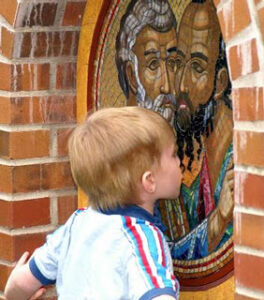
Venerating the Icon of Saints Peter and Paul
The most common way of venerating an icon is to kiss the icon. When Orthodox Christians enter the church they kiss the icon of Christ or bow their heads briefly as a sign of respect and confession of Christ’s lordship. They also kiss the icons of the saints or touch the icon briefly as a gesture of affection.
This practice has biblical roots. St. Paul wrote in several of his letters: “Greet one another with a holy kiss” (Romans 16:16; I Corinthians 16:20; I Thessalonians 5:26). St. Peter wrote the same thing in I Peter 5:14. The Bible also contains references to people kissing Christ. In Luke 7:45 Jesus rebuked his host for omitting the common courtesy of greeting him with a kiss. In Psalm 2:12, a Messianic psalm, we find the admonition: “Kiss the Son, lest he be angry and you be destroyed in your way…. (NIV)”
Much of Protestant iconoclasm rests on ontology. A huge chasm in how they understand the structure of reality separates the Reformed tradition from Orthodoxy. Protestants for the most part view reality as two distinct and separate realms: the physical and the spiritual. Divine revelation takes place principally by means of a divinely inspired text; other sources of knowledge are subordinate to the sacred text, the Bible. The Reformed tradition is for the most part anti-sacramental. It rejects the notion of sacraments, i.e., divine grace conveyed through physical objects. This is especially the case with modern American Presbyterianism. But in the case of Calvin himself and Mercersburg Theology there is an openness to divine grace conveyed spiritually through the physical object (water/bread/wine) but not in direct connection with the material object. For the Reformed Christian, the physical matter wine/bread/water is necessary for the spiritual blessing to occur but there is no spiritual benefit in the physical object per se.
For many Protestants baptism is understood as an outward sign of one’s inner faith in Christ. Holy Communion likewise for many Protestants is an intellectual exercise in which the elements serve to remind us of Christ’s death on the cross and stimulate our faith in Christ. The ontology of the Protestant tradition allows for divine revelation principally in an intellectual form hence the stress on propositional content in theology and the emphasis on the study of the Bible in discipleship.
The Orthodox understanding of reality is that the physical and the spiritual overlap, i.e., there is an integration or synergy between the material and the spiritual. We do not draw a clear cut distinction between the physical and the spiritual; rather we draw the distinction between the created cosmos (which is both physical and spiritual) and the Uncreated Creator. The ontology of the Orthodox world view allows for the possibility of sacraments: the waters of baptism conveying the grace of regeneration; the Bible as both the human word and the word of God; and the bread and wine becoming the body and blood of Christ in the Eucharist. Orthodox approach ontology is not a dichotomistic either-or like in Protestantism but rather both-and.
The Protestant either-or worldview extends to the after life. Protestants are adamantly opposed to praying for the dead or asking the intercession of the departed saints. If one thinks about it this worldview separates the church militant from the church triumphant. One could even say that this is an act of schism. Furthermore, this assumption is a repudiation of the line in the Apostles Creed about the communion of saints. Thus, the Protestant staunch belief in this ontological divide means that icons of the saints are mere pictures that at best serve as reminders or teaching aids but cannot connect us with the departed saints who are beyond our mental imaginations.
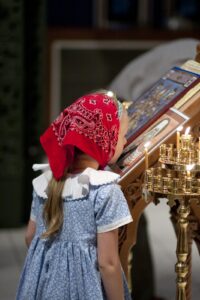
Venerating the Icon in Nashville, TN
The Orthodox both-and worldview opens the way for the idea of the communion of saints, a very ancient teaching as evidenced by the Apostles Creed affirmation of the communion of saints. It means that those who have fallen asleep in the Lord are now part of the great cloud of witness in Hebrews 12:1. Christ’s resurrection has shattered the gates of Hell. Where before death resulted in an uncrossable chasm, with Christ’s Paschal victory the wall of separation between living and the dead has become tenuous.
So when Orthodox Christians venerate icons they are showing love and respect not to the two dimensional images but to the persons depicted in these images. For the Orthodox the departed saints are not far from us. Because we along with the departed saints are alive in Christ and because Christ has conquered death not even death can break this fellowship we have with each other. That is why the early Church in the Apostles Creed confessed its belief in the “communion of saints.” The saints are not abstract historical figures but beloved family members whom we love and who we pray with. In the Divine Liturgy the church militant here on earth and the church triumphant in heaven are united around the throne the God. This calls for a major readjustment in the Western mindset to integrate the physical and spiritual dimensions as Scripture, the Fathers, and the ancient liturgies have done.
From a pastoral perspective the Orthodox worldview offers comfort for those recently bereaved. If you saw a widower standing over a grave telling his beloved wife how much he missed her, would you tell him that he’s committing a sin? Or would you tell him that this is a good form of emotional release? Wouldn’t it be better to say that she’s with the Lord and that she’s part of the great cloud of witness who are praying for us?
I suspect that part of what lies behind many Protestants’ iconoclasm is the physicality of the act of venerating icons. So much (most) of Protestant worship is cerebral; one sings songs and listens to the sermon. But it doesn’t have to be that way. If Martin Luther did not have a problem with a physical gesture of making the sign of the Cross then it’s not that big a jump to kissing the Bible or a cross. Love involves outward visible expression. Can one love someone without showing it? St. John admonishes us in I John 4:18 to love in word and in truth.
There are passages in the Bible that point to physical actions having spiritual significance. In Mark 5:27-30 we read about a sick woman who by touching Jesus’ clothes received physical healing. Her healing was the result of her faith in Jesus and power going out from him into her body. In Acts 5:15 we read of Peter’s shadow having a healing effect on people. In II Timothy 1:6 Paul reminds Timothy of the spiritual charism that he received through the laying on of hands, i.e., his consecration to the ministry. In Isaiah 6 we see the angel telling Isaiah:
See, this has touched your lips; your guilt is taken away and your sin atoned for.
The physical contact of the coal with Isaiah’s lips is not magic but a sacramental act. Isaiah was spiritually ready to receive this hot fiery coal that not even a seraph could handle by his confession of his sinful state.
What I am trying to show here is that when Orthodox Christians kiss an icon or touch an icon with their fingers they are engaging in a mind-body-spirit action that reaches across from this physical dimension into the heavenly dimension. In Orthodoxy we access the spiritual dimension with both our minds and our bodies, the Reformed tradition seems to access the spiritual dimension principally through the intellect.
Orthodox Veneration of the Saints vs. Protestant Soli Deo Gloria
Wesley objects to the veneration of the saints by invoking the principle of soli deo gloria. But the mere invoking of a slogan is not enough. Wesley must show the biblical basis for making this assertion. My response is that the denial that the saints are vessels of glory is contrary to Scripture. Because humanity is created in the image of God, we were created for glory and we were created to give glory to God. In Psalm 8:6 we read:
You made him a little lower than the angels;
You crowned him with glory and honor (NKJV).
Paul understood glory to be part of the human condition. In I Corinthians 11:7 he writes:
A man ought not to cover his head, since he is the image and glory of God…. (NIV)
Glory or fame is one of the blessings God bestows on his followers. In Genesis 12:2 God promises Abram: “I will make your name great.” In Psalm 84 we read of Yahweh bestowing glory on his followers:
He will give grace and glory (Psalm 84:11 NKV)
In Psalm 149 we read:
The holy ones shall boast in glory. (vs. 5 NKJV)
This glory have all the holy ones. (vs. 9 NKJV)
Where “glory” can be taken to mean fame in this present life, in the book of Daniel we find a prophecy that point to God bestowing eternal glory on his followers:
Those who understand shall shine like the brightness of the firmament, and some who are righteous, like the stars of heaven forever and ever (12:3 NKJV)
In the coming of Christ we find a fulfillment of the Old Testament promises. For much of his earthly life Jesus’ divine glory was concealed with several exceptions. One was the theophany on the Mount of Transfiguration. What is interesting is the account in Luke which records that Moses and Elijah “appeared in glorious splendor” talking with Jesus (Luke 9:30-31). Just before his Passion Jesus prayed for the Christians:
I have given them the glory that you gave me, that they may be one as we are one (John 17:22; NIV)
Furthermore, our glorification is just as much a part of our salvation as our justification. Paul wrote:
And those he predestined, he also called; those he called, he also justified; those he justified, he also glorified (Romans 8:3; NIV)
The glorification of the saints does not detract from God’s glory but rather enhances it. Paul writes in II Thessalonians 1:10:
…when He comes, in that Day, to be glorified in His saints and to be admired among all those who believe, because our testimony among you was believed. (NKJV; emphasis added)
Our glory comes from our being united with Christ and our living for Christ. Paul writes in I Corinthians 10:31:
So whether you eat or drink or whatever you do, do it all for the glory of God. (NIV)
To conclude, our glory is not independent of God’s glory. It is rooted in the synergy of our salvation in Christ. We were created in the image of God and we were created to give glory to God. To the extent the saints are glorified God is glorified even more. Orthodoxy takes a both-and approach to glory; this allows for the honoring of those whose lives exemplified Christian discipleship. In venerating the saints the church militant on earth affirms its fellowship with the church triumphant in heaven. The Protestant either-or understanding in the soli deo gloria greatly weakens our link to the church triumphant. This can be seen in the widespread neglect of church history among Protestants.
The clearest explanation of the relation of God’s glory and our salvation in Christ is to be found in C.S. Lewis’ essay “The Weight of Glory.” He points out that glory does not mean shining like a light bulb but rather being praised by God for being a good and faithful servant. Thus, the icons hanging on the walls of an Orthodox church are like a portrait gallery of the heroes of the faith. This is much like the way we honor athletes who through their hard work won regional championships or the way we honor who served the nation through their sacrifice and bravery.
If Reformed Christians seek to rigorously apply the principle of soli deo gloria they would need to advocate the emptying of trophy cases in high schools honoring the football teams and the removal of portraits of veterans who served their country. However, I’m sure Reformed Christians like Wesley would recognize the benefit of the secular practice of honoring those who exemplify our community’s values and ideals.
Therefore, the Protestant tenet soli deo gloria is unbiblical. Based upon the above analysis I am persuaded that Scripture supports Orthodoxy’s both-and approach of God being glorified in his saints, and refutes the Protestant either-or understanding which ascribes glory exclusively to God. I strongly suspect that soli deo gloria was formulated as a reaction to the excesses of medieval Roman Catholicism. If Wesley wants to invoke the principle of soli deo gloria against the Orthodox veneration of the saints he needs to: (1) show how this principle is grounded in Scripture, (2) how Scripture contradicts the Orthodox veneration of the saints, and (3) how the Protestant soli deo gloria is not a theological novelty but part of the historic Christian faith in the first millennium.
Robert Arakaki
Return to Top. Home.
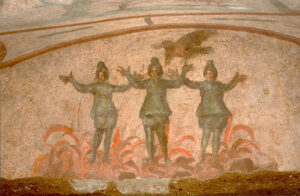
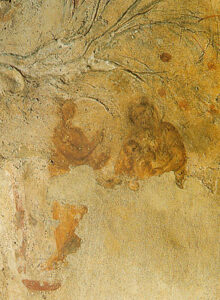


Recent Comments